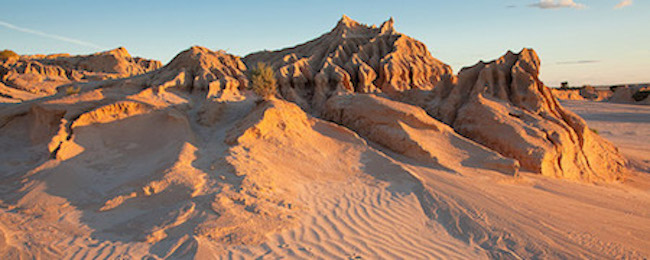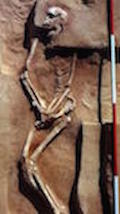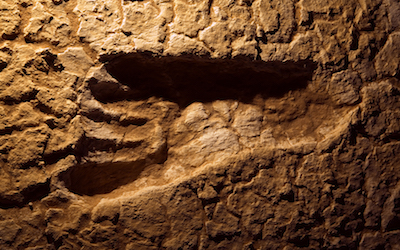



Mungo national Park is part of the Willandra Lakes region and is abundant in archaeological treasures, rich in cultural history and thriving animal populations. Surrounded by the Walls of China, fragile sand formations sculpted over time by erosion.
Mungo man and Mungo lady are arguably the most important human remains found in Australia. Dating back to over 40,000 years their remains demonstrate the emergence of spiritual beliefs through burial rituals and how long the aboriginals have been here. Mungo Lady was found in 1969 and is the oldest cremation in the world.  The burn marks on the bones give evidence to suggest that the body was burned, the bones crushed and then burned again before she was buried under a cover of ochre around the Willandra lakes region. Mungo man, found in 1974 and estimated to be 1.7 metres tall is the earliest evidence of aboriginal burial rituals. He was buried on his back, hands in his lap and sprinkled with red ochre. His two lower canine teeth were knocked out most likely from a ritual when he was young. Notice the wear on the back molars of Mungo man’s skull signifying a gritty diet. After analysis on bones it was clear he had arthritis and died around 50 which at the time was quite old. The red ochre that is evident in both burials could only reach Lake Mungo by trade. Mungo man and Mungo Lady is very significant to aboriginal tribes and the archaeological world because it demonstrates the emergence of spiritual beliefs with elaborate burial rituals and long distance trade.
The burn marks on the bones give evidence to suggest that the body was burned, the bones crushed and then burned again before she was buried under a cover of ochre around the Willandra lakes region. Mungo man, found in 1974 and estimated to be 1.7 metres tall is the earliest evidence of aboriginal burial rituals. He was buried on his back, hands in his lap and sprinkled with red ochre. His two lower canine teeth were knocked out most likely from a ritual when he was young. Notice the wear on the back molars of Mungo man’s skull signifying a gritty diet. After analysis on bones it was clear he had arthritis and died around 50 which at the time was quite old. The red ochre that is evident in both burials could only reach Lake Mungo by trade. Mungo man and Mungo Lady is very significant to aboriginal tribes and the archaeological world because it demonstrates the emergence of spiritual beliefs with elaborate burial rituals and long distance trade.
There are 457 footprints in the lake mungo footprints collection, found in 2003 and believed to be 19 000 - 23 000 years old. The fossilised footprints were made by a tall group of adults and children likely heading north towards other lakes for food they offered. A layer of clay above the footprints and dry sand has prevented the footprints from eroding. Through these footprints we can get a clearer understanding of Aboriginal lifestyle. The set of shallow footprints indicates an aboriginal hunter sprinting off the balls of his feet in pursuit of prey and demonstrates hunting tactics.The size of the footprint gives us an insight into the physical appearance, gender and age of these people and finally how they interacted with each other.
